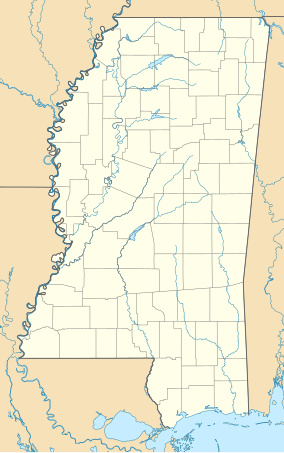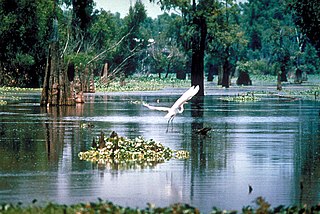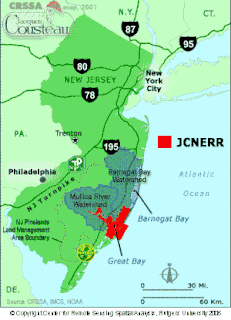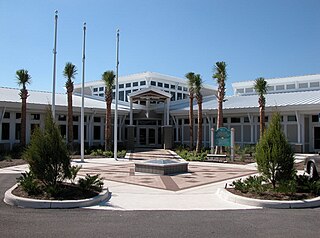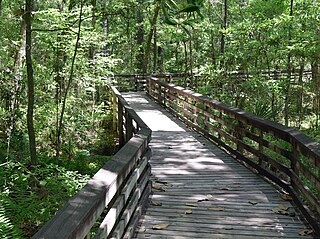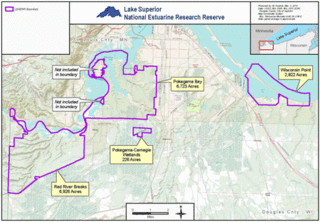This article includes a list of references, but its sources remain unclear because it has insufficient inline citations .(May 2017) (Learn how and when to remove this template message) |
| Grand Bay National Estuarine Research Reserve | |
|---|---|
Aerial view showing eroding shoreline along Rigolets | |
Map of Mississippi | |
| Location | Mississippi, United States |
| Nearest city | Pascagoula |
| Coordinates | 30°22′38″N88°26′02″W / 30.3773°N 88.434°W Coordinates: 30°22′38″N88°26′02″W / 30.3773°N 88.434°W |
| Area | 18,400 acres (7,400 ha) |
| Established | 1999 |
| nerrs | |
The Grand Bay National Estuarine Research Reserve is one of the most biologically productive estuarine ecosystems in the Gulf of Mexico region, supporting several rare or endangered plant and animal species, numerous important marine fishery resources, diverse habitat types and archaeological sites, in the U.S. State of Mississippi.

The Gulf of Mexico is an ocean basin and a marginal sea of the Atlantic Ocean, largely surrounded by the North American continent. It is bounded on the northeast, north and northwest by the Gulf Coast of the United States, on the southwest and south by Mexico, and on the southeast by Cuba. The U.S. states of Texas, Louisiana, Mississippi, Alabama, and Florida border the Gulf on the north, which are often referred to as the "Third Coast", in comparison with the U.S. Atlantic and Pacific coasts.
In biology, a species ( ) is the basic unit of classification and a taxonomic rank of an organism, as well as a unit of biodiversity. A species is often defined as the largest group of organisms in which any two individuals of the appropriate sexes or mating types can produce fertile offspring, typically by sexual reproduction. Other ways of defining species include their karyotype, DNA sequence, morphology, behaviour or ecological niche. In addition, paleontologists use the concept of the chronospecies since fossil reproduction cannot be examined. While these definitions may seem adequate, when looked at more closely they represent problematic species concepts. For example, the boundaries between closely related species become unclear with hybridisation, in a species complex of hundreds of similar microspecies, and in a ring species. Also, among organisms that reproduce only asexually, the concept of a reproductive species breaks down, and each clone is potentially a microspecies.

Generally, a fishery is an entity engaged in raising or harvesting fish which is determined by some authority to be a fishery. According to the FAO, a fishery is typically defined in terms of the "people involved, species or type of fish, area of water or seabed, method of fishing, class of boats, purpose of the activities or a combination of the foregoing features". The definition often includes a combination of fish and fishers in a region, the latter fishing for similar species with similar gear types.
The reserve encompasses coastal bay, expansive saltwater marshes, maritime pine forest, pine savanna and pitcher plant bogs. It supports extensive and productive oyster reefs and seagrass habitats. It also serves as nursery area for many of the Gulf of Mexico's important recreational and commercial marine species, such as shrimp, blue crab, speckled trout, and red fish.
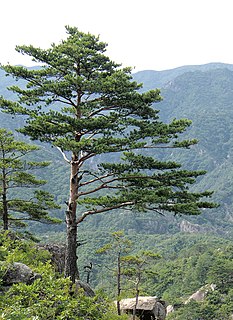
A pine is any conifer in the genus Pinus of the family Pinaceae. Pinus is the sole genus in the subfamily Pinoideae. The Plant List compiled by the Royal Botanic Gardens, Kew and Missouri Botanical Garden accepts 126 species names of pines as current, together with 35 unresolved species and many more synonyms.

A forest is a large area dominated by trees. Hundreds of more precise definitions of forest are used throughout the world, incorporating factors such as tree density, tree height, land use, legal standing and ecological function. According to the widely used Food and Agriculture Organization definition, forests covered 4 billion hectares (9.9×109 acres) (15 million square miles) or approximately 30 percent of the world's land area in 2006.

A savanna or savannah is a mixed woodland grassland ecosystem characterised by the trees being sufficiently widely spaced so that the canopy does not close. The open canopy allows sufficient light to reach the ground to support an unbroken herbaceous layer consisting primarily of grasses.
As part of the Grand Bay Savannah Conservation Partnership, the Grand Bay Reserve is participating in a prescribed burn management program for the East Mississippi Sound Region. This project is widely supported by local and state government agencies as well as the oil and gas industry with facilities in adjacent fire-dependent woodlands.
The Grand Bay Coastal Resources Center Interpretative Area is the headquarters for the Reserve and the Grand Bay National Wildlife Refuge. Completed in 2009, the Center features interpretive exhibits, classrooms, laboratories and a dormitory. Environmental education programs for and special events are offered. Visitor activities include hiking, boating, paddling, photography, fishing and hunting.

Grand Bay National Wildlife Refuge was established in 1992 under the Emergency Wetlands Resources Act of 1986 to protect one of the largest expanses of undisturbed pine savanna habitats in the Gulf Coastal Plain region. The refuge is located near Grand Bay, Alabama in Mobile County, Alabama and Jackson County, Mississippi, and when complete will encompass over 32,000 acres (130 km2). The refuge is part of the National Wildlife Refuge system. The Refuge Complex Manager also administers the Mississippi Sandhill Crane National Wildlife Refuge and Bon Secour National Wildlife Refuge. Access to refuge lands is limited, but is available mostly on the Mississippi side and by boat.

